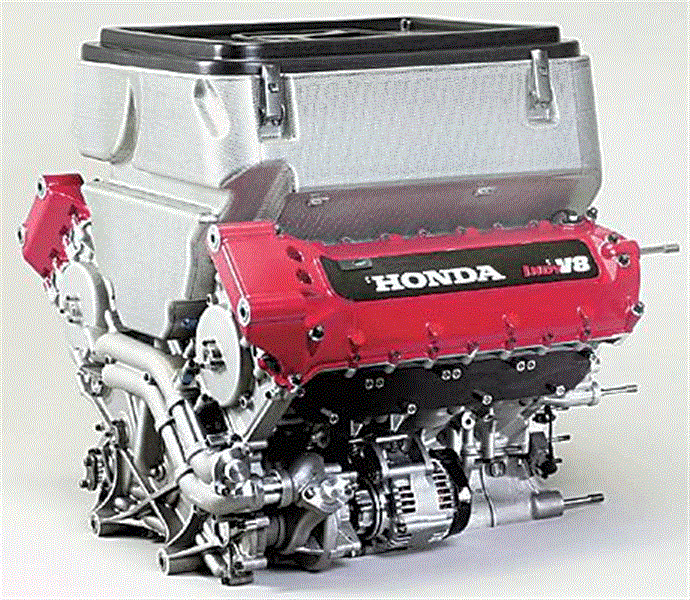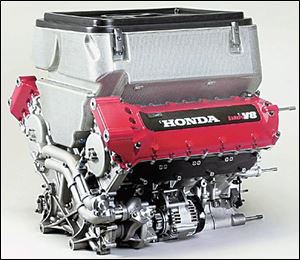
Michigan 400 at MIS: Honda's engines up front
7/31/2004
Honda engines have won eight poles in 2004.
BROOKLYN, Mich. - It is all about controlled explosions. About harnessing the violent reaction that takes place inside an internal combustion engine when a highly volatile fuel is combined with oxygen, compressed and a spark is introduced.
The best racing engine squeezes a maximum amount of power from every last drop of fuel. It masters that ultimate conflict of interest - power versus economy.
This year, the king of the mountain is Honda.
Its engines have dominated the competition in the Indy Racing League. As of this juncture, Honda's performance is vintage New York Yankees with Mantle and Maris, the Boston Celtics with Bill Russell, or the unbeaten 1972 Miami Dolphins.
As the circuit moves to Michigan International Speedway for tomorrow's Michigan 400, Honda is on a considerable hot streak. Cars powered by its engines have won eight of the nine races in the IndyCar Series - the last eight in a row - and blown away the competition from Toyota and Chevrolet on several occasions.
In last week's race at Milwaukee, Honda driver Dario Franchitti won the race, and Hondas powered seven of the top 10 cars in the field. In the season points race, the top three drivers, and six of the top 10, sit in front of a Honda engine on race day.
Nowhere was Honda's dominance more emphatic than at the Indianapolis 500 in May, when the top seven spots in the IRL's signature race went to Honda-powered cars. In the recent race in Kansas, Honda grabbed the first six places in the field.
The Honda 3.0 liter HI4R Series Indy V-8 will push from zero to 100 miles per hour in three seconds, impart G-forces equal to four times the weight of gravity, and top out at more than 220 miles per hour. But in a sport where everyone is fast, Honda is a bit faster.
"Honda has done its homework, no question about it," Indy 500 winner Buddy Rice, one of the principal beneficiaries of the Honda surge, said. "They have come out this year and been super strong. The power is there. You can just look at last year and see how different things were."

Honda engines have won eight poles in 2004.
Last year, Honda's first in the IRL, the company posted just two race wins and took three pole positions, while Toyota dominated the ranks with 11 wins in 16 races, and Chevrolet won three times. It was clearly not what the folks at Honda Performance Development (HPD), a subsidiary of American Honda Motor Co., Inc., that coordinates Honda's participation in the IRL, had in mind.
"Last year's performance was below our expectations," said Robert Clarke, general manager of HPD. "We knew we had a lot of ground to cover. We did not have the overall experience the other engine manufacturers had, and we were all on a major learning curve."
Clarke, a former professor of art and architecture at Notre Dame, said Honda started marshaling the troops late last season in a concentrated effort to develop better-performing engines. It partnered with Ilmor Engines, a Michigan-based engine maker.
"We targeted the off-season as a time to make significant changes," he said. "We got all of the engineers together and made a plan of attack. We felt there were a lot of opportunities to improve, but we had to change our frame of mind, and develop the organization."
The particulars are cloaked in secrecy for obvious reasons, but the depth of the commitment is common knowledge. Honda had 90 people working at its 43,000-square-foot facility outside Los Angeles last winter, and will open a new 123,000-square-foot facility there later this year. Another 35 engineers and technicians were involved in the engine project at the Plymouth, Mich., facility of Ilmor.
"We put our nose to the grindstone," Clarke said.
The IRL rules are very strict in regards to the architecture and dimensions of the engines, but Clarke said there was still space for improvement.
"We found a lot of opportunities," he said. "Even with all of the guidelines and restrictions, there is still room for ingenuity."
Clarke said competition in the engine development area keeps all of the manufacturers relentlessly pushing for more.
"These things run in cycles, and nobody stays on top indefinitely, so we know we have to work even harder and continue to make gains to keep the competition at bay," he said. "Since Indy, they're not falling back, so they are either keeping pace with our development, or closing the gap."
In yesterday's practice runs at MIS, points race-leader Tony Kanaan's Honda powered Andretti-Green Racing car was the fastest, but until the actual race takes place, no one knows for certain which engine will perform the best this week. It was much the same way coming into the current season.
"You can do all of this work in the winter, but you never really know where you're at until you line up for that first race, and until the green flag flies," Clarke said. "Fortunately, we came out this year smelling like a rose."
Honda leases its engines to the racing teams, at a cost of $1.65 million per season. That gives the team access to a pool of five to seven engines.
Clarke said the extensive research and development costs involved make it difficult to determine the precise value of each engine, which he estimated at just under a quarter of a million dollars.
"Honda's dedication to motorsports is second to none," Andretti Green driver Dan Wheldon, who has two wins with Honda this season, said. "When we won, the Honda was a rocket. They have earned these wins, and it's a privilege to be associated with them."
Rahal Letterman driver Vitor Meira said he and Wheldon have clearly benefited from Honda's move to the top.
"It's all about work," said Meira, who won the pole at Milwaukee with a Honda. "Last year, there were other brands that had the edge, but this year we are pushing the pace. That's all from the work they did in the off-season. And even though we've had more horsepower at the start, we keep adding and adding and adding for every race."
Meira said he expects the competition in engine development to remain as intense as that which takes place on the race track.
"They will work harder to stay on top than they did to get there," Meira said. "In everything in life, sometimes you are up and sometimes you are down. Right now, it's our turn to be up and I'm sure Honda will do everything it can to maintain this advantage we have for as long as we can. It's real comfortable to get into the car, knowing that even if you make a little mistake, the horsepower we have will let you make it up. Racing is all about getting out front and staying there, and right now, the Hondas are the ones running out front."
Contact Matt Markey at:
mmarkey@theblade.com
or 419-724-6510.